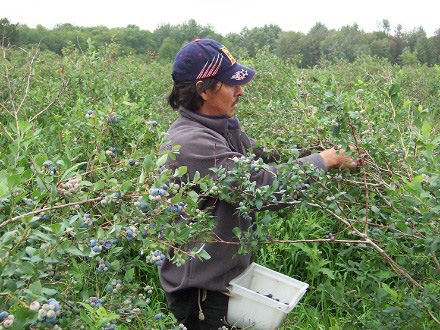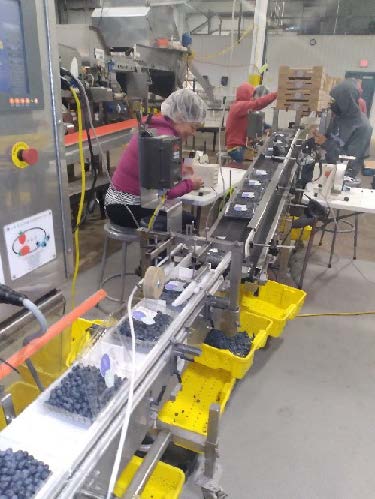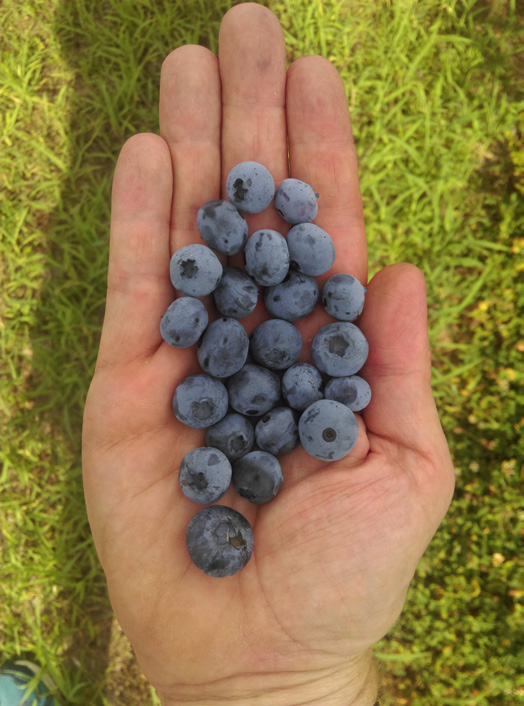
MSU Extension Supports Michigan's Blueberry Industry
DOWNLOADJuly 24, 2023 - Michigan State University Extension
Impacts
- 6,600 plus permanent jobs provided by Michigan blueberry industry¹
- $132 million annual economic contribution by Michigan blueberry industry²
- The Michigan blueberry industry provides more than 6,600 jobs on an annual full-time equivalent bases.¹
- The Michigan blueberry industry has over 500 family farms.
- The Michigan blueberry industry generates $10 million in business taxes.¹
Priority Areas
Michigan agriculture contributes more than $104.7 billion annually to our state’s economy.² In 2019, the fruit and nut industry had an estimated farm gate value of $361.7 million.³ Apples, blueberries, cherries and grapes are the main fruit crops of Michigan. Michigan’s fruit industry relies on Michigan State University (MSU) for timely research and outreach programming to sustain the viability, employment and profitability of their farms. Thus, the MSU fruit team’s research and extension priorities are maintaining or increasing productivity and fruit quality to help fruit growers remain competitive in a global marketplace.
More specifically, the Michigan Blueberry industry has an estimated $530 million economic direct and indirect impact in Michigan.¹ There are currently 21,700 acres in production. 4 The average cost of production for blueberries grown in Michigan is $13,441 per acre,¹ and as a result, this industry is highly reliant on MSU Extension for new information to continue farming blueberries successfully in the state.
To find out more information or to find an expert near you, visit https://www.canr.msu.edu/fruit/. John Wise, MSU professor, wisejohn@msu.edu, 517-432-2668 Carlos Garcia-Salazar, MSU Extension educator, garcias4@msu.edu, 616-994-4580
Strengthening Partnerships Within Michigan's Blueberry Industry
The blueberry industry established a Michigan Department of Agriculture and Rural Development (MDARD) checkoff program to address top concerns of Michigan blueberry growers. In 2017, the Michigan Blueberry Commission was formed "with the goal of improving the economic position and competitiveness of the Michigan blueberry industry by supporting research, education, and promotion program."5
In 2021, this partnership funded $700,738 in competitive grant dollars to maintain and expand MSU Extension programming and applied research to address grower-established priorities. These funds also provided partial funding for the southwest blueberry Extension educator and small fruit horticultural specialist positions that were filled in 2021.
Additionally, in partnership with the Michigan State Horticultural Society and the Michigan fruit industries, the MSU Extension fruit team is responsible for fruit educational sessions at the Great Lakes Fruit, Vegetable and Farm Market Expo in Grand Rapids, Michigan. In 2022, the fruit educational sessions attracted 1,055 growers from all over the country. Fruit sessions represented 35% of registered attendance to this event.
"I saw a few great talks from growers in the berry and blueberry sessions. It was nice to see that industry perspective from leading growers and learn from their experiences." -Great Lakes Fruit, Vegetable and Farm Market Expo session participant
Helping Blueberry Growers Manage Pest & Weather-Related Challenges

In 2021, the MSU Extension fruit team addressed top blueberry industry concerns through survey data and feedback provided by Michigan blueberry growers during the 2019 and 2020 season. The survey was sent to 450 small fruit growers to determine and prioritize key challenges affecting today’s blueberry industry. Respondents identified insect pests (23.3%) to be the top concern for Michigan blueberry growers. Insect control in blueberries has topped priority lists as a result of two invasive insect pests introduced into the state: spotted wing Drosophila and blueberry stem gall wasp.
In 2012, according to the Michigan blueberry industry, spotted wing Drosophila caused direct economic losses estimated at $28 million. In 2014, Latino blueberry growers reported losses amounting to 58% of their expected income. In addition, pest control expenses increased from $150 in 2012 to more than $372 per acre in 2013 as a result of spotted wing Drosophila. Furthermore, the blueberry stem gall wasp, once a minor pest of blueberry, is resulting in considerable losses to the annual blueberry crop. In 2019, growers reported the blueberry stem gall wasp to be a major pest problem in 828 acres of blueberries. By 2021, the infested acreage increased to 1,115 aces. The economic impact to manage blueberry stem gall wasp is estimated to cost $111.70 to $123.63 per acre. However, the only effective blueberry stem gall wasp control strategy is to eliminate infested fields.6

The MSU fruit team has developed educational materials and conducted outreach programming that has refined blueberry growers’ integrated pest management programs. Surveys indicate that 46.8% of growers have used educational materials from MSU Extension that were provided during educational training meetings. The survey data also indicate that 25.4% of respondents used information posted on the MSU Extension Spotted Wing Drosophila website (https:// www.canr.msu.edu/ipm/Invasive_species/spotted_ wing_drosophila/index), and 18.6% of growers used handouts provided during face-to-face meetings.
The MSU fruit team has helped reduce the number of applications of pesticides against spotted wing Drosophila, blueberry stem gall wasp and fruit rots; growers reduced the number of insecticide applications against spotted wing Drosophila from 12 applications in 2013 to seven sprays in 2021. Growers also reported decreased costs to manage these pests from $372 per acre in 2013 to $158.8 per acre in 2021. Furthermore, growers reported fewer crop losses in recent years: from 56% losses in 2013 to 27% crop loss in 2021.
Additionally, 23.3% of respondents indicated climate and weather-related challenges (winter mortality, spring frost/freeze events and summer drought) to be major concerns for the future of blueberry farming in the state. Survey data also indicated that marketing (17.8%) and lack of labor (15.1%) were top concerns for blueberry growers. Although only 12.22% considered blueberry diseases to be a top issue, 57.8% of survey respondents considered two fruit rots, Alternaria and Anthracnose, to be pre- and post-harvest problems.

References
¹U.S. Highbush Blueberry Council. (n.d.). The economic impact of blueberry growers in the state of Michigan. https://blueberry.org/ushbc/wp-content/uploads/ sites/5/2020/12/FINAL-Michigan-USHBC-EIR-Full Study-7-30-20.pdf.
²Michigan Department of Agriculture and Rural Development. (2019, Rev.). Michigan agriculture facts and figures. https://www.michigan.gov/-/ media/Project/Websites/mdard/documents/ business-development/mi_ag_facts_figures. pdf?rev=9ca97e867d0d40b392470b02a2694e50
³Department of Agriculture, National Agriculture Statistics Service. (2020). 2019-2020 Michigan annual bulletin sections as available. https://www.nass.usda. gov/Statistics_by_State/Michigan/Publications/ Annual_Statistical_Bulletin/stats20/index.php
4U.S. Department of Agriculture, National Agriculture Statistics Service. (2019). Michigan fruit inventory 2018-2019. https://www.nass.usda.gov/Statistics_by_ State/Michigan/Publications/Michigan_Rotational_ Surveys/mi_fruit18/Blueberries.pdf
5State of Michigan, Office of the Governor. (2023). Michigan Blueberry Commission. https://www. michigan.gov/whitmer/appointments/oma/all/2/ michigan-blueberry-commission
6Garcia-Salazar, C. Miles, T., & Isaacs, R. (2022). [Unpublished]. End-of season IPM evaluation 2021.



 Print
Print Email
Email


